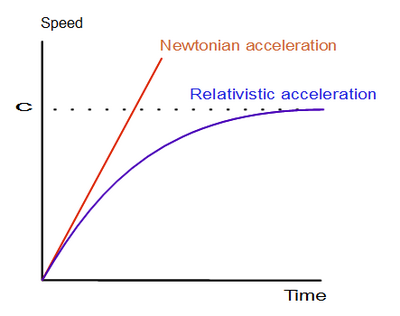A Roller Coaster Ride through Relativity/Appendix A
The 1g rocket problem
[edit | edit source]Consider a rocket accelerating from rest at a constant acceleration of 1g. What do we actually mean by this, taking relativistic effects into account? Obviously the rocket cannot go on increasing its speed at a constant rate (from the point of view of someone who remains at rest), because it would eventually travel faster than light. What happens is that the rocket approaches the speed of light exponentially like this.

So what do we mean by constant acceleration? Well, from the point of view of the astronauts on board, what we mean is that they experience a constant artificial gravity field which is produced by the steady thrust of the continuously firing rocket motors, which feels exactly like 1g back on Earth. To them, the spacecraft is permanently stationary but the universe outside the ship appears to be passing by faster and faster in the same way as in the illustration above.
Now it might appear that we need to use the ideas of General Relativity here, but that is not necessary. We just need to define carefully what we mean by this sort of acceleration. In a Newtonian world, if an object travelling at a speed v accelerates with an acceleration a for a small time δt, the final speed is given by
In a relativistic world, however , we must use the relativistic formula for the addition of velocities (see appendix *), ie:
This leads to
Eliminating the second order term we get:
Now all we have to do is to integrate this expression to find out how v varies with t. First separate the variables:
Now integrate:
Fortunately this is a standard integral which my maths book tells me is:
(Since v = 0 at t = 0, there is no constant of integration). A bit of simple manipulation leads us to the first result:
NB the time t referred to here is the integral of the proper time, which is the journey time - ie the time as experienced on board ship. So this formula tells you how fast you will be going after you have been travelling for a time t.
Next it would be nice to know how far you get in this time. To do this we must take into account the fact that the faster you go, the more contracted the miles that pass by are! In a Newtonian world the distance δs travelled in a short time δt at a speed v is:
but in a relativistic world, you actually get a lot further because all the distances outside your ship are length contracted by a factor of γ so:
Substituting our formula for the speed of our ship after a time t we get:
Integrating this expression leads to:
We can't ignore the constant of integration this time because at t = 0, s = 0 but cosh(0) is 1 not zero. The final result is therefore:
The third thing we should like to know is how old will our friends be when we get back! Well, for every second we travel at a speed v our stay-at-home friends will age γ seconds ie:
from which we obtain:
(the constant of integration is zero because sinh(0) = 0 as required)
I find it particularly pleasing that the solution to the problem of the 1g rocket has such simple and elegant answers, particularly when we work in years and light years. In these units, both a and c are equal to 1. If we think of a round trip which is to take T years (as measured on board), the outward journey will consist of two phases, an acceleration for T/4 years, and a deceleration phase of the same length. The return journey will be just the same.
The maximum speed reached will be:
The distance you get to will be:
and the age of your newborn baby son when you get back will be:
To give you an idea of what these expressions look like in practice, here is a table of results:
| Journey time (y) | Max speed (% of c) | Distance (ly) | Age of son (y) |
|---|---|---|---|
| 0 | 0 | 0 | 0 |
| 1 | 24 | 0.1 | 1 |
| 2 | 46 | 0.3 | 2 |
| 3 | 64 | 0.6 | 3 |
| 4 | 76 | 1.1 | 5 |
| 5 | 85 | 2 | 6 |
| 6 | 91 | 3 | 9 |
| 7 | 94 | 4 | 11 |
| 8 | 96 | 6 | 15 |
| 9 | 98 | 8 | 19 |
| 10 | 99 | 10 | 24 |
It is worth noting that a return journey to a star 10 light years away would (theoretically) only take 10 years of astronaut time (24 years back at home). If you are prepared to journey for 20, 30 or 40 years, you could get to stars 150, 1800 and 22,000 ly away respectively (that is a quarter of the way across the galaxy!) and if you are not bothered about coming home you could travel to the edge of the known universe in a mere 47 years (although whether there would be any universe left by the time you got there is another matter!).

























